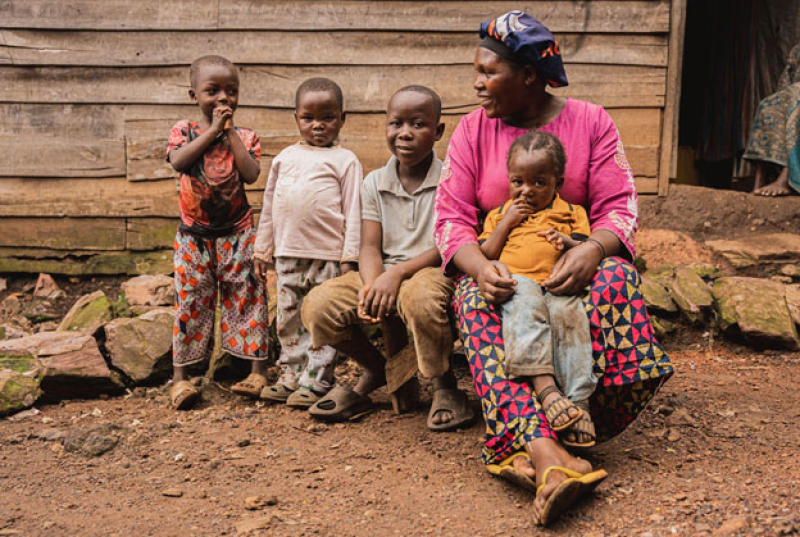- Hurricane Melissa: UN Appeals $74M to Aid 2.2M in Cuba |
- Doha Summit Stresses Urgent Investment in People and Peace |
- Sand syndicates tighten grip on Bangladesh's northern region |
- Prof Yunus orders security forces to hunt down Ctg attackers |
- IU suspends 3 students for assaulting journos, warns 9 others |
WFP Warns of Emergency Hunger as Global Aid Dries Up

Mwavita Rohomoya sits with her four children in front of her drink stall in Minova, Kalehe territory, South Kivu province, DR Congo, on 23 April 2025. Minova is one of the first areas in South Kivu to be affected by the resurgence of violence, one of the immediate consequences was the rise in prices of staple foods and essential goods. UNICEF’s cash transfer programme helped families meet their urgent needs—buying food, finding shelter, and accessing healthcare—while also enabling some, like Mwavita, to invest in small-scale income-generating activities.
In 2025, unprecedented cuts to foreign aid and humanitarian funding have deepened global hunger crises, leaving millions without access to food or basic services. Funding shortfalls have forced aid agencies to scale back or suspend lifesaving programmes in some of the world’s most food-insecure regions, particularly across the Global South — worsening already dire conditions caused by conflict, displacement, economic instability, and climate shocks.
On 15 October, the World Food Programme (WFP) released a report titled A Lifeline at Risk: Food Assistance at a Breaking Point, illustrating the impact of funding shortfalls on its operations in six countries — Afghanistan, the Democratic Republic of the Congo (DRC), Haiti, Somalia, South Sudan, and Sudan. In these nations, funding cuts have had devastating consequences, pushing entire communities to the brink of starvation.
“We see significant reductions in our operations and those of our partners,” said Ross Smith, WFP’s Director of Emergency Preparedness and Response. “That goes from cutting people completely off assistance, reducing rations, and shortening the duration of aid. Many vulnerable people are now completely without a safety net or a landing pad.”
The report highlighted that the number of people in urgent need of food and livelihood assistance has surged to a record high of 295 million in 2025 — coinciding with major reductions in foreign aid and humanitarian funding from key donors, including the United States. As a result, WFP has been forced to drastically scale back its operations, grappling with an estimated 40 per cent cut in funding that has severely limited its ability to deliver lifesaving support to the world’s hungriest populations.
WFP warned that recent funding cuts could “severely undermine global food security”. It is estimated that roughly 13.7 million people who depend on WFP food assistance could be pushed into emergency levels of hunger, with children, women, refugees, and internally displaced people being disproportionately affected.
“These cuts are triggering additional food insecurity that could have impacts at both national and regional levels,” said Jean-Martin Bauer, Director of WFP’s Food Security and Nutrition Analysis Service.
WFP noted that the full impact of these funding cuts would not be immediate but unfold in the coming months. “This is why we call it a ‘slow burn’ in the report,” said Bauer. “Because the cuts haven’t fully fed through the system yet to all countries and communities.”
Bauer warned that escalating hunger amid dwindling aid could have far-reaching implications, including rising rates of child marriage, school dropouts, social instability, displacement, and economic and political turmoil. Furthermore, WFP has recorded increased malnutrition rates among children in refugee communities, with many facing lifelong health challenges as a result.
One of WFP’s most pressing challenges has been the reduction of disaster-preparedness programmes in crisis-prone countries, as resources are redirected to sustain emergency food assistance for the most affected populations. In Haiti, WFP has been forced to suspend its hot-meal programme for displaced families and cut monthly rations in half as the nation continues to grapple with record hunger levels.
Bauer noted that Haiti’s contingency stock of humanitarian aid has been fully depleted and, for the first time since Hurricane Matthew in 2016, WFP has been unable to replenish it. The agency continues to closely monitor Haiti’s food security situation.
Similarly, Smith reported that conditions in Afghanistan have worsened considerably over the year, with fewer than 10 per cent of the country’s 10 million food-insecure people now receiving humanitarian aid. “We expect pipeline breaks as early as November and can currently only provide limited winter assistance,” said Smith, noting that less than 8 per cent of those in need of winterisation support will receive it.
In the Democratic Republic of the Congo (DRC), WFP has been forced to reduce its operations from 2.3 million people to just 600,000 and warns that resources could be entirely depleted by February next year without additional funding. In Somalia, WFP’s reach has also been drastically reduced, with the agency now able to assist less than 25 per cent of those it supported last year.
In Sudan, WFP managed to assist roughly 4 million people in August — half of them in hard-to-reach areas such as Darfur and South Kordofan. “We are shifting away from what used to be a very large programme, in the absence of significant government support, to one now focused on famine prevention — moving from hotspot to hotspot,” said Smith. In neighbouring South Sudan, WFP has redirected its limited resources to prioritise civilians facing the most extreme levels of hunger.
According to the report, WFP has recalibrated its food assistance priorities amid shrinking aid budgets and staff reductions, choosing to focus on famine prevention and providing food rations that reach fewer people but meet basic needs. Bauer added that it is imperative for humanitarian groups to align with local actors and continue to closely monitor hunger levels.
“The data and analytics — they’re the humanitarian community’s GPS,” Bauer said. “We risk losing our way without the data. So the data must flow.”

